Related Research Articles

The Atari Jaguar is a home video game console developed by Atari Corporation and released in North America in November 1993. Part of the fifth generation of video game consoles, it competed with the 16-bit Sega Genesis, the Super NES and the 32-bit 3DO Interactive Multiplayer that launched the same year. Powered by two custom 32-bit processors – Tom and Jerry – in addition to a Motorola 68000, Atari marketed it as the world's first 64-bit game system, emphasizing its 64-bit bus used by the blitter. The Jaguar launched with Cybermorph as the pack-in game, which received divisive reviews. The system's library ultimately comprised only 50 licensed games.

The 3DO Company, also known as 3DO, was an American video game company. It was founded in 1991 by Electronic Arts founder Trip Hawkins, in a partnership with seven other companies. After 3DO's flagship video game console, the 3DO Interactive Multiplayer, failed in the marketplace, the company exited the hardware business and became a third-party video game developer. It went bankrupt in 2003 due to poor sales of its games. Its headquarters were in Redwood City, California, in the San Francisco Bay Area.

The 3DO Interactive Multiplayer, also referred to as simply 3DO, is a home video game console developed by The 3DO Company. Conceived by entrepreneur and Electronic Arts founder Trip Hawkins, the 3DO was not a console manufactured by the company itself, but a set of specifications, originally designed by Dave Needle and RJ Mical of New Technologies Group, that could be licensed by third parties. Panasonic produced the first models in 1993, and further renditions of the hardware were released afterwards by GoldStar, Sanyo, Creative Labs, and Samsung Electronics in 1997.
The fifth generation era refers to computer and video games, video game consoles, and handheld gaming consoles dating from approximately October 4, 1993, to March 23, 2006. For home consoles, the best-selling console was the Sony PlayStation, followed by the Nintendo 64, and then the Sega Saturn. The PlayStation also had a redesigned version, the PSone, which was launched on July 7, 2000.

War Gods is a fighting video game originally released to arcades by Midway Games in 1996. Ports for the Nintendo 64, PlayStation and Windows were released in 1997. In the game, players control one of ten fighters who have been given great power by a mysterious ore that crashed-landed on Earth from outer space. The object of the game is to defeat all the other fighters to become the most powerful warrior on the planet.

Madden NFL 98 is a 1997 football video game. It was the last edition of the Madden series to be released for the Super NES, Genesis and Sega Saturn platforms, as well as the last Madden game to utilize 2D sprites for the players and referee, on 3D playing fields.
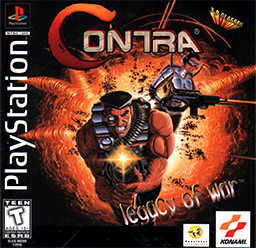
Contra: Legacy of War is a 3D action game produced by Konami and developed by Appaloosa Interactive that was originally released in 1996 for the PlayStation and Sega Saturn. It is a follow-up to Contra: Hard Corps, and was the first of two games in the Contra series that were externally developed by Appaloosa; the second game, C: The Contra Adventure, was released in 1998. Legacy of War marks the series' shift to three-dimensional graphics and gameplay, the game was released packaged with a pair of 3D anaglyph glasses, which enables the player to view the 3D effects incorporated into the game's graphics. Legacy of War bears the distinction for being the first console game in the series to retain both the Contra title and human characters during its release in Europe and Australia. The game was scheduled to be released in Japan as well, but was cancelled.

Crash 'N Burn is a futuristic racing/shooter video game developed by Crystal Dynamics and released for the 3DO in 1993. The game was the launch title for the system and was included as a pack-in game with Panasonic's original 3DO console.
Disruptor is a 1996 first-person shooter video game developed by Insomniac Games and published by Universal Interactive Studios and Interplay Productions for the PlayStation. It was the first game developed by Insomniac Games. The game released on November 30, 1996 in North America and in December of that year in Europe. It received positive reviews from critics, but was a commercial failure, selling well below the company’s expectations.
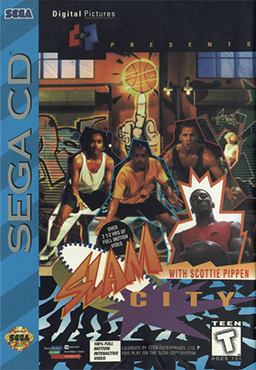
Slam City with Scottie Pippen is the first FMV basketball video game. It was developed by Digital Pictures for the PC and CD-ROM-based video game consoles such as the Sega CD. Scottie Pippen stars in the game, and performed the theme song. Ron Stein, who had previously directed the video footage for Prize Fighter, directed the video footage for the game. A 3DO Interactive Multiplayer version was announced but never released.
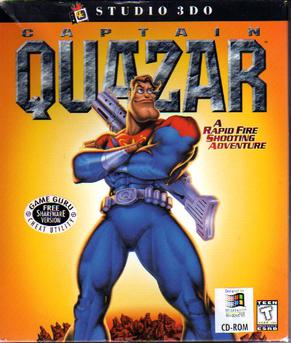
Captain Quazar is a science fiction third-person action game by developer Cyclone Studios, first published in 1996 by 3DO. Though initially released as an exclusive for 3DO's Interactive Multiplayer console, after the system was discontinued, Captain Quazar was ported to the Windows 95 PC platform in 1997.

Iron & Blood: Warriors of Ravenloft is a 3D fighting game released for PC and PlayStation.
Cyclone Studios was an American video game developer and publisher based in San Mateo, California. It developed several titles for the 3DO Interactive Multiplayer and later Microsoft Windows.
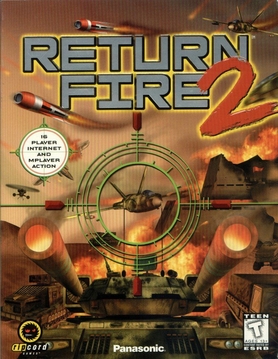
Return Fire 2 is a computer game developed by Silent Software and published for Windows by Ripcord Games in 1998. It is a sequel to Return Fire.

BattleSport is a 1996 futuristic sports video game developed by Cyclone Studios. It was originally published by Studio 3DO exclusively for their 3DO Interactive Multiplayer in 1996, but after the 3DO was discontinued BattleSport was published for other systems by Acclaim Entertainment. It was released for Windows and PlayStation, Sega Saturn, and Windows in North America in July 1997, and in Europe on August 1, 1997.
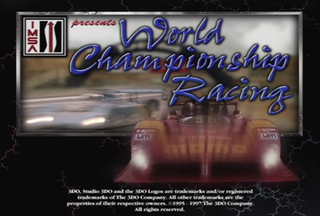
IMSA World Championship Racing is an unreleased sports prototype racing video game that was in development and planned to be published by Studio 3DO on a scheduled fall 1997 release date exclusively for the Panasonic M2. Had it been released before the launch of the console was cancelled, it would have become the first officially licensed title by the International Motor Sports Association and one of the first titles to be launched before the system it was designed for.
References
- ↑ "M2 1/2 in 1998, Trip Speaks Out". Electronic Gaming Monthly . No. 79. Sendai Publishing. February 1996. pp. 16–18.
- ↑ "3DO M2 / Arcade Review: Konami's Polystars". Archived from the original on 2006-01-04. Retrieved 2005-12-06.
- ↑ "Overseas Readers Column - Konami To Develop Coin-Op Videos Using 64-bit "M2"". Game Machine (in Japanese). No. 513. Amusement Press, Inc. 1 March 1996. p. 30.
- ↑ Webb, Marcus (May 1996). "Konami, Matsushita Plan 64-Bit Home and Arcade Sister Systems". Next Generation . No. 17. Imagine Media. p. 26.
- ↑ "Planetweb and Panasonic to Bring the Internet to the Interactive Kiosk Marketplace; Panasonic Internet-enabled M2 Interactive Kiosks to Preview at KioskCom 2000". Business Wire. 2000-04-10. Retrieved 2008-03-16.
- ↑ "Don't Count Out 3DO's New M2". Electronic Gaming Monthly . No. 72. Sendai Publishing. July 1995. p. 26.
- ↑ "3DO Powers Up". GamePro . No. 74. IDG. November 1994. p. 272.
- 1 2 3 4 5 "Exploring M2: A Closer Look at 3DO's Newest Technology". Electronic Gaming Monthly . No. 71. Sendai Publishing. June 1995. pp. 60–61.
- ↑ "E3: 3DO". Next Generation . No. 7. Imagine Media. July 1995. p. 19.
- ↑ "Letters". Next Generation . No. 15. Imagine Media. March 1996. p. 106.
- ↑ "Matsushita Grabs M2". GamePro . No. 88. IDG. January 1996. p. 22.
- 1 2 "More Power to M2". Electronic Gaming Monthly . No. 87. Ziff Davis. October 1996. pp. 20–22.
- 1 2 "3DO's M2 Prepares for its Debut". Next Generation . No. 10. Imagine Media. October 1995. pp. 14–15.
- ↑ "3DO and its Partners Getting Ready for the 64-Bit Battle". Electronic Gaming Monthly . No. 73. Sendai Publishing. August 1995. p. 26.
- ↑ "Matsushita Buys 3DO M2 Technology". Next Generation . No. 13. Imagine Media. January 1996. pp. 18–19.
- ↑ "Developers Worry About M2's Future". Next Generation . No. 16. Imagine Media. April 1996. p. 18.
- ↑ "Divorce Absolute for Sega and M2". Next Generation . No. 18. Imagine Media. June 1996. p. 19.
- ↑ "The World According to Trip". Next Generation . No. 22. Imagine Media. October 1996. p. 165.
- ↑ "Milk the Clock". Electronic Gaming Monthly . No. 82. Ziff Davis. May 1996. pp. 16–17.
- ↑ "Will DVD Change the Face of Videogames?". Next Generation . No. 18. Imagine Media. June 1996. pp. 41–42.
- 1 2 3 "Which Game System is the Best!?". Next Generation . No. 12. Imagine Media. December 1995. pp. 79–81.
- ↑ "Show Notes". GamePro . No. 95. IDG. August 1996. p. 16.
- 1 2 3 4 5 6 7 8 9 10 11 "World Exclusive: M2 Specs Revealed". Next Generation . No. 26. Imagine Media. February 1997. pp. 16–17.
- 1 2 "M2 Jitters?". Electronic Gaming Monthly . No. 90. Ziff Davis. January 1997. p. 21.
- ↑ "License to Kill - M2 Axed: 3DO Reacts". Electronic Gaming Monthly . No. 99. Ziff Davis. October 1997. p. 27.
- 1 2 Matthews, Will (December 2013). "Ahead of its Time: A 3DO Retrospective". Retro Gamer . Imagine Publishing (122): 26.
- ↑ "Matsushita Kills the M2". GamePro . No. 108. IDG. September 1997. p. 20.
- ↑ Mullen, Micheal (July 3, 1997). "M2, We Hardly Knew You". GameSpot . Archived from the original on May 4, 1999. Retrieved July 29, 2022.
- 1 2 "Matsushita: Finally Pulling the Plug". Next Generation . No. 33. Imagine Media. September 1997. pp. 20–21.
- ↑ "Where Was the M2?". Electronic Gaming Monthly . No. 98. Ziff Davis. September 1997. p. 73.
- ↑ "M2's Second Life". Electronic Gaming Monthly . No. 102. Ziff Davis. January 1998. p. 22.
- 1 2 "Matsushita M2: Hit or Myth?". Next Generation . No. 30. Imagine Media. June 1997. pp. 62–63.
- 1 2 "M2". Next Generation . No. 6. Imagine Media. June 1995. pp. 36–40.
- 1 2 "3DO's M2 Technology". GamePro . No. 82. IDG. July 1995. p. 16.
- ↑ "D2". GamePro . No. 92. IDG. May 1996. p. 42.
- ↑ "NG Alphas: Power Crystal". Next Generation . No. 29. Imagine Media. May 1997. pp. 72–75.
- ↑ "In the Studio". Next Generation . No. 28. Imagine Media. April 1997. p. 19.
- ↑ Brevik, David (11 May 2016). "Diablo: A Classic Game Postmortem". Game Developers Conference (conference talk). 30 minutes in. Retrieved 6 January 2019– via YouTube.
- ↑ "Celebrity Sightings". GamePro . No. 92. IDG. May 1996. p. 21.
- ↑ "Cutting Edge - 3DO buoyant as M2 picks up speed". Edge . No. 23. Future Publishing. September 1995. pp. 6–7.
- ↑ "Preview - Coming Soon - M2". 3DO Magazine . No. 10. Paragon Publishing. May 1996. p. 34.
- ↑ "News - E3 '96: 3DO? - M2 Dream List". 3DO Magazine . No. 12. Paragon Publishing. July 1996. p. 4.
- ↑ "Preview - Coming Soon - M2". 3DO Magazine . No. 12. Paragon Publishing. July 1996. p. 34.
- ↑ "M2: Matsushita Breaks its Silence". Next Generation . No. 22. Imagine Media. October 1996. pp. 16–19.
- ↑ "Topics: Wiretap - Something's Up M2's Sleeve". Ultra Game Players . No. 99. Imagine Media. July 1997. p. 20.
- ↑ Yin-Poole, Wesley (1 February 2020). "3DO M2 collector releases playable demo disc for free". Eurogamer. Retrieved 5 February 2021.